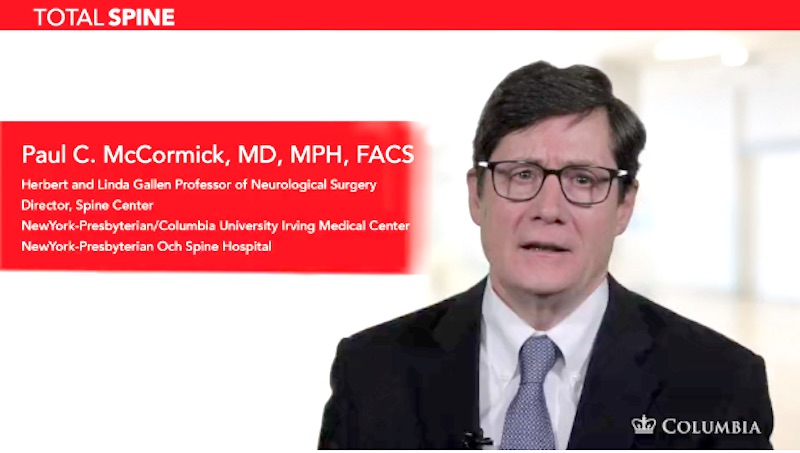| What is Instrumented Spinal Fusion? | Instrumented = using instruments such as rods, plates, screws, cages, and hooks
Spinal = having to do with the spine
Fusion = a process in which bones “fuse,” or permanently grow together
Instrumented spinal fusion is a procedure in which a surgeon uses instruments such as rods, plates, and screws to help bones in the spine fuse, or grow together.
An instrumented spinal fusion is performed in adult or pediatric patients when the spine has been weakened by degenerative conditions, deformity, trauma, tumor, or surgery. The purpose of the procedure is to restore spinal strength so that the spine can withstand normal day-to-day stresses and can also protect the spinal cord and nerves against more excessive forces that are occasionally encountered.
The basic premise of a spinal fusion is the creation of a bone “bridge” that connects strong and healthy bone above the weakened spinal segment with strong and healthy bone below it. To build this bone bridge, the surgeon places bone graft, or small pieces of bone, across the span where fusion is desired. The graft may be taken from the patient’s own body (an autograft) or from a bone bank (an allograft).
There are proteins in the human body that encourage bones to grow and fuse; they naturally assist during the healing of a fracture. These proteins, called bone morphogenic proteins (BMPs), may also be used to encourage bones to grow together after a spinal fusion. In some patients, the surgeon may use bone substitutes, bone extenders, and biologics like demineralized bone matrix or hydroxyapatite to assist in strong bone growth.
In an instrumented spinal fusion, instruments–rods, plates, screws, cages, and/or hooks–hold the bones in place while they fuse. The instruments are generally made of titanium, stainless steel, or cobalt chrome. Screws or hooks are inserted into the weakened vertebrae, as well as into adjacent healthy vertebrae. The screws or hooks serve as strong anchors to the spine. These anchors are then attached to metal rods that span the weakened segments, forming a metallic bridge. Forces can be applied to the rods to correct deformities and straighten the spine.
The metallic “bridge” formed by the instruments provides immediate strength and stability to the spine, but it is not a long-term solution. The instruments will never be as strong as on the day they are implanted. Normal activities of everyday life may strain them, and eventually the instruments may fail. Long-term spinal stability is best achieved with good fusion of the bones. The process of bone fusion takes several months–up to a year or more for patients with fusions that extend over several spinal segments.
When good fusion is achieved, the instruments are no longer necessary. However, they are usually left in place to avoid additional surgery. (In the few cases where good fusion is not achieved, the surgeon evaluates the specific case and forms an individualized plan for further treatment.)
|
| When is this Procedure Performed? | An instrumented spinal fusion may be performed to treat mechanical pain (pain from a moving joint) or for conditions or surgical procedures that would otherwise compromise spinal stability.
- Mechanical pain: When pain arises from movement at a spinal joint, eliminating the movement at that joint may eliminate the pain. However, instrumented spinal fusion is not the first treatment of choice for mechanical pain. Significant benefit can often be derived from nonoperative measures like physical therapy, which can help a patient strengthen the muscles of the lower back and abdominal wall. It is important to realize that instrumented spinal fusion is a major surgery, with all the risks and recovery considerations normally entailed by such a procedure. In addition, fusing bones in the spine may put additional strain on spinal segments above and below the fusion. Mechanical pain treated with fusion may simply develop again as other spinal segments take the strain.
- Conditions that may compromise spinal stability: Degenerative conditions like spondylolisthesis, spinal deformities like scoliosis, or trauma like an odontoid fracture may render the spine unstable. An instrumented spinal fusion may be performed to restore spinal stability.
- Surgical procedures that may compromise spinal stability: Many operations that successfully treat tumors, trauma, malformations, or degenerative conditions are followed by a spinal fusion to restore spinal stability.
Like any other surgery, an instrumented spinal fusion has its pros and cons. When compared with a non-instrumented spinal fusion, an instrumented spinal fusion has some clear benefits and some potential drawbacks.
Benefits of instrumented spinal fusion include:
- Immediate spinal stability
- Increased rate of bone fusion
- Correction of spinal deformity
- Prevention of further deformity
Potential risks of instrumented spinal fusion include:
- Increased chance of infection or other complications
- Creation of rigidity that may one day lead to further mechanical problems
- Increased amount of time in operating room
- Increased soft tissue disruption and therefore perhaps postoperative pain
|
| How is this Procedure Performed? | This procedure is performed under general anesthesia, which means the patient is unconscious and can not feel pain during the procedure.
In certain cases, before performing the spinal fusion the surgeon decompresses the spinal cord or nerve roots to alleviate pain and remove damaged tissue. In patients patients with deformities such as scoliosis or kyphosis, our surgeons may remove a portion of the spinal column to loosen or release the deformity, allowing the spine to be realigned.
Spinal fusion may be performed at any level of the spine: cervical, thoracic, lumbar or sacral. In some patients with weakness or instability at the very highest level of the spine, the fusion may extend to the base of the skull, a so-called occipito-cervical fusion. In the lower part of the spine, the fusion may also be extended to the pelvis, a so-called spino-pelvic fusion.
Posterior fusions, or fusions from the back of the spine, often use instruments called pedicle screws. These are specialized bone screws that are implanted into the pedicles, thick, sturdy sections of bone at the back of the spine. Pedicle screws do not provide stability themselves, but provide attachment points for the rods, inserted next, that form the “span” of the metal bridge.
Anterior fusions, or fusions at the front of the spine, usually take place where a disc has been removed (a procedure called a discectomy) or a vertebral body has been removed (a corpectomy). The front of the spine bears much of the weight of the body, so implants in this area must be extremely strong. Manufactured implants made from titanium, carbon fiber, or polyetheretherketone (PEEK) are common. These devices are often open in the center and can be filled with bone graft or bone substitute. The bone graft inside the device can then fuse with the vertebrae above and below. Sometimes, a solid piece of bone is used as an implant in an anterior fusion. Plates and screws may help support any type of anterior implant and keep it in place as the bones heal. Examples of anterior fusion surgeries are anterior cervical discectomy, anterior cervical corpectomy, anterior lumbar interbody fusion (ALIF) and extreme lateral interbody fusion (XLIF). Many of these procedures can be performed using a minimally invasive approach at the Spine Hospital at the Neurological Institute of New York.
Circumferential fusions involve both the front and the back of the spine. In the thoracic and lumbar spine, a circumferential fusion may sometimes be performed through one incision at the back of the spine. In other cases, two separate procedures will be performed, one from the front and one from the back. These two procedures may be performed on the same day, during the same period of anesthesia (consecutive procedures) or on separate days (staged procedures). Examples of circumferential fusions performed through the back (posterior) of the spine are a transforaminal interbody lumbar fusion (TLIF), pedicle subtraction osteotomy (PSO), and vertebral column resection (VCR).
After the instruments are implanted, the surgeon uses bone graft to connect the bones that will eventually fuse. Autograft may come from bone removed during the surgery, or it may be harvested from a patient’s iliac crest (hip bone), since bone can usually be removed here without causing problems. Allograft may be obtained from a bone bank. Fusion of the graft may be aided by a concentrated form of a substance called bone morphogenic protein (BMP). BMP is naturally produced by the body, and can sometimes aid bony fusion. Other biologic materials may be used to assist with bone fusion healing.
The surgeons at the Spine Hospital at the Neurological Institute routinely use advanced techniques and technologies like image guidance, robotics and intraoperative CT scanning with the O-Arm to increase the precision, safety and effectiveness of spinal fusion in our patients.
|
| How Should I Prepare for this Procedure? | Make sure to tell your doctor about any medications that you’re taking, including over the counter medication and supplements, especially medications that can thin your blood such as aspirin. Your doctor may recommend you stop taking these medications before your procedure. To make it easier, write all of your medications down before the day of surgery.
Be sure to tell your doctor if you have an allergy to any medications, food, or latex (some surgical gloves are made of latex).
Nicotine significantly affects how the bones will fuse after the procedure. For the best chance at a positive outcome, stop using tobacco well before surgery. If you currently smoke or use other tobacco products, speak to your neurosurgeon about quitting.
On the day of surgery, remove any nail polish or acrylic nails, do not wear makeup and remove all jewelry. If staying overnight, bring items that may be needed, such as a toothbrush, toothpaste, and dentures.
|
| What Should I Expect After the Procedure? | In properly selected patients spinal fusion is associated with excellent outcomes; over 90 percent of patients achieve a solid fusion and derive significant benefit from the surgery.
To increase the likelihood of a successful fusion, the surgeon may look to eliminate or reduce risk factors that may increase the probability of a failed fusion. Smoking, poorly controlled diabetes, chronic steroid use, anti-inflammatory medications (e.g. aspirin) or other therapies that reduce the body’s immune or anti-inflammatory response may increase the risk of a failed fusion, also called a non-union or pseudoarthrosis. Periodic X-rays or even CT scans are performed after surgery to assess the progress of the bone fusion.
|
| Preparing for Your Appointment | Drs. Paul C. McCormick, Michael G. Kaiser, Peter D. Angevine, Alfred T. Ogden, Christopher E. Mandigo, Patrick C. Reid and Richard C. E. Anderson (Pediatric) are experts in instrumented spinal fusion.
|


